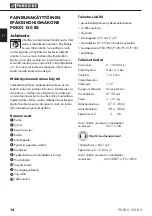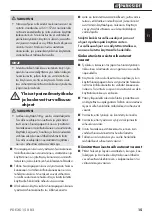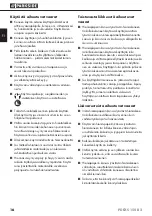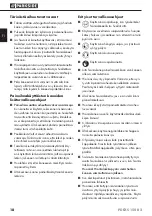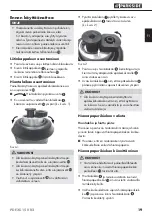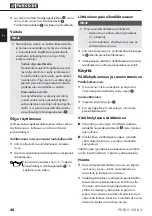
5
PDEXS 150 B2
GB
IE
Risks due to dust and vapours
■
The dust and vapours produced by using the
sander or polisher can be hazardous to health
(e.g. cause cancer, birth defects, asthma and/
or dermatitis); it is essential to carry out a risk as-
sessment in respect of these risks and to imple-
ment corresponding regulatory mechanisms.
■
The risk assessment should include all dust
caused by the use of the machine and any exist-
ing dust that may be whirled up at the same time.
■
The sander or polisher is to be operated and
maintained in accordance with the recommen-
dations contained in this manual to keep the
release of dust and vapours to a minimum.
■
The exhaust air should be routed so that the
raising of dust in already dusty environments
is kept to a minimum.
■
If dusts or vapours are created, the main priority
must be to control these at the site of their release.
■
All inserts or accessories of the machine in-
tended for collecting, extracting or suppressing
airborne dust or vapours or should be used and
serviced in accordance with the manufacturer’s
instructions.
■
Consumables/machine tools should be selected,
maintained and replaced in accordance with
the recommendations in this guide in order to
avoid unnecessary intensification of dust or
vapour production.
■
Use breathing equipment as per the instructions
provided by your employer or as required by
health and safety regulations.
Risks due to noise
■
Excessive noise levels in conjunction with insuffi-
cient hearing protection may lead to permanent
hearing damage, hearing loss and other prob-
lems, such as tinnitus (ringing, buzzing, whistling
or humming in your ears). Therefore it is essential
that a risk assessment is carried out with respect
to these risks and that appropriate regulatory
mechanisms are implemented.
■
Suitable regulatory mechanisms include measures
such as the use of insulation materials to avoid
pinging occurring on the workpieces.
■
Use ear protection equipment as per the instruc-
tions provided by your employer or as required
by health and safety regulations.
■
The sander or polisher is to be operated and
maintained in accordance with the recommen-
dations contained in this manual to reduce any
unnecessary increase of the noise levels.
■
Consumables/machine tools should be selected,
maintained and replaced in accordance with
the recommendations in this guide in order to
avoid unnecessary increase of the noise levels.
■
If the sander or polisher is equipped with a
silencer, always ensure that this in its place and
is operational while the machine is in operation.
Risks due to vibrations
■
Vibrations can damage the nerves and cause
malfunctions to the blood circulation in the
hands and arms.
■
When working in a cold environment, wear warm
clothing and keep your hands warm and dry.
■
If you notice numbness, tingling or pain in your
fingers or hands or notice that the skin of your
fingers or hands has become pale, stop working
with the sander or polisher and consult a doctor.
■
The sander or polisher is to be operated and
maintained in accordance with the recommen-
dations contained in this manual to reduce any
unnecessary increase of the vibrations.
■
Hold the machine securely but not too firmly
while maintaining the necessary hand-reaction
force, as the vibration risk generally increases
the harder the machine is held.
Additional safety instructions for
pneumatic machines
■
Compressed air can cause serious injury.
Ensure that the air supply is switched off, the
hose is not under pressure and that the machine
is disconnected from the air supply when not
in us, and also before exchanging accessories
or carrying out repairs. Never aim the airflow
towards yourself or any other person.
■
Thrashing hoses can cause serious injury.
Therefore, always check that the hoses and their
fixings are not damaged or have not come loose.
Summary of Contents for 110141
Page 3: ......
Page 15: ...12 PDEXS 150 B2 ...
Page 27: ...24 PDEXS 150 B2 ...
Page 39: ...36 PDEXS 150 B2 ...

















